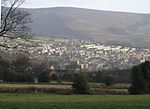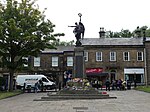Glossop North End A.F.C.
Glossop North End Association Football Club is a football club in Glossop, Derbyshire, England, which compete in the North West Counties League Premier Division. Their home ground is Surrey Street, which has a capacity of 1,301 (200 seated, 1,101 standing). The club play in blue, and are nicknamed the Hillmen or the Peakites. Between 1899 and 1992 the club was officially known simply as Glossop. Glossop is one of the smallest towns in England to have had a Football League club, and it remains the smallest town whose team has played in the English top-flight.The club was founded in February 1886 and joined the North Cheshire League four years later. Glossop spent two seasons each in The Combination and the Midland League, before moving to North Road and being elected into the Football League Second Division in 1898. Having been promoted in the 1898–99 season, they spent one season in the First Division. During this period the club was bankrolled by Sir Samuel Hill-Wood, who was later to become chairman of Arsenal. The club retains some connections with Arsenal. Glossop were relegated in 1900 and spent the next fifteen seasons in the Second Division, before exiting the Football League during World War I. Glossop North End spent 1920 to 1957 in the Manchester League, being crowned champions in 1927–28. They moved from the Lancashire Combination back to the Manchester League in 1966, and then spent four seasons in the Cheshire County League from 1978. Glossop were founder members of the North West Counties League in 1982 and won Premier Division title at the end of the 2014–15 campaign. They were beaten finalists in the FA Vase in 2009 and 2015.
Excerpt from the Wikipedia article Glossop North End A.F.C. (License: CC BY-SA 3.0, Authors).Glossop North End A.F.C.
Surrey Street, High Peak Whitfield
Geographical coordinates (GPS) Address Website External links Nearby Places Show on map
Geographical coordinates (GPS)
| Latitude | Longitude |
|---|---|
| N 53.445277777778 ° | E -1.9577777777778 ° |
Address
Glossop North End AFC
Surrey Street
SK13 7AJ High Peak, Whitfield
England, United Kingdom
Open on Google Maps









